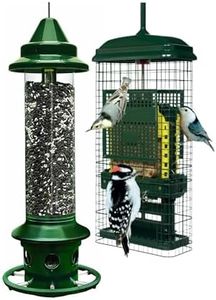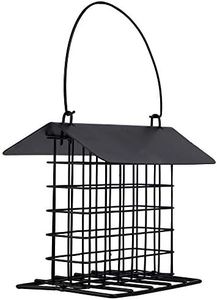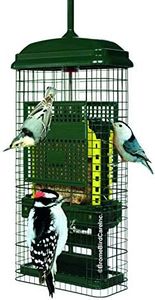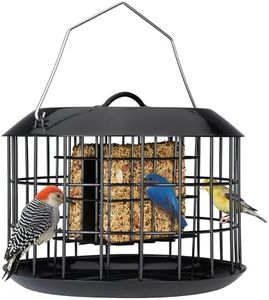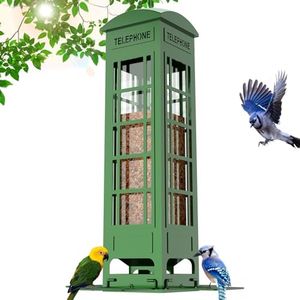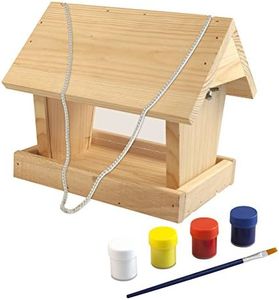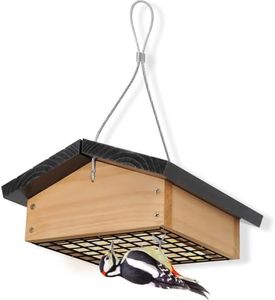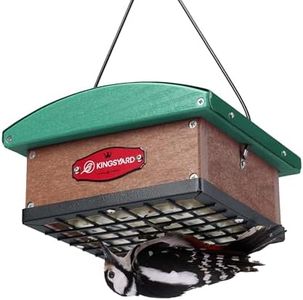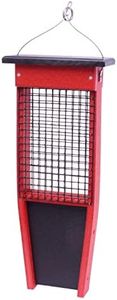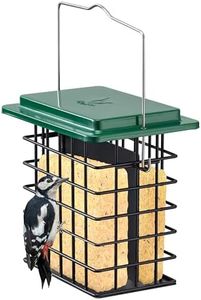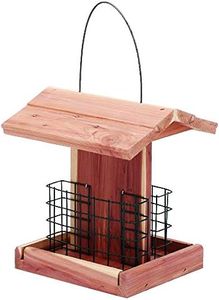We Use CookiesWe use cookies to enhance the security, performance,
functionality and for analytical and promotional activities. By continuing to browse this site you
are agreeing to our privacy policy
10 Best Woodpecker Feeder
From leading brands and best sellers available on the web.Buying Guide for the Best Woodpecker Feeder
Selecting a woodpecker feeder is about providing an inviting and suitable space for woodpeckers to feed in your yard or garden. Woodpeckers are unique birds with specialized feeding habits, so choosing the right feeder ensures they are attracted to your space, can feed comfortably, and are kept safe from predators and competitors.Feeder TypeFeeder type refers to the basic design and mechanism of the woodpecker feeder. The most common types are suet feeders, tail-prop feeders, and hopper feeders. Suet feeders are popular for woodpeckers because they provide high-energy food in the form of suet cakes, which woodpeckers love. Tail-prop feeders have a special extension at the bottom that allows woodpeckers to brace their tails for stability, mimicking their natural behavior on tree trunks. Hopper feeders can hold a mix of seeds and nuts, but may not always attract all woodpecker species. When choosing a feeder type, consider what foods you want to offer and if you want to watch natural woodpecker feeding behavior.
MaterialMaterial is about what the feeder is made from—commonly wood, metal, or durable plastic. Wooden feeders blend naturally into the outdoor environment and can be appealing to woodpeckers, but may require more maintenance. Metal feeders are more durable and pest-resistant, especially against squirrels, but can heat up in direct sun. Plastic feeders are lightweight and often easy to clean but may not be as long-lasting. If you want something that lasts and is easy to clean, look for weather-resistant materials. Think about your climate and how much maintenance you’re comfortable with when choosing material.
Feeder CapacityFeeder capacity refers to how much feed the feeder can hold. Smaller capacity feeders require more frequent refilling but keep food fresher, while larger capacity models reduce the frequency of refilling but can sometimes attract other, non-woodpecker birds or pests. If you see woodpeckers often and want to minimize maintenance, a larger feeder may be suitable, but if you only occasionally spot them, a smaller feeder is fine and helps prevent leftover food from going bad.
Accessibility for WoodpeckersAccessibility means how easy it is for woodpeckers to feed from the feeder. Woodpeckers like to cling vertically, so look for feeders that allow this posture and include a tail-prop panel for stability. Feeders with perches or grids that mimic tree bark also help attract woodpeckers. If you want to increase your chances of attracting woodpeckers, choose a feeder that supports their natural feeding posture.
Ease of CleaningEase of cleaning refers to how simple it is to disassemble and wash the feeder. Feeders should be cleaned regularly to prevent the spread of disease and mold, especially suet feeders. Look for feeders that are easy to take apart and have smooth surfaces without many small nooks where debris can collect. If you prefer little hassle with maintenance, prioritize feeders described as easy to clean.
Weather ResistanceWeather resistance describes how well the feeder stands up against rain, snow, sun, and wind. A good feeder should protect the food from getting wet and spoiled and should not degrade quickly outside. Features like powder-coated metal, water-resistant wood, or built-in roofs help protect both the feeder and the food inside. If your area experiences harsh weather, prioritize a more durable, weatherproof design.
Pest ProtectionPest protection refers to the features that prevent squirrels, raccoons, or large birds from accessing the food. Some feeders come with protective cages or baffles, or have mechanisms to limit access to only woodpecker-sized birds. If your area has a lot of squirrels or other wildlife, look for feeders that emphasize pest deterrence so you can ensure the food is reserved for woodpeckers.
